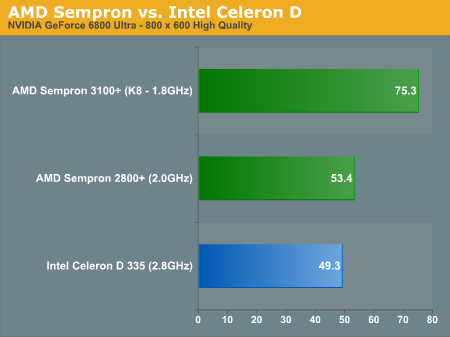Battle 3: Celeron D vs. Sempron
AMD just recently introduced their new low-end branded CPU: Sempron, and as we've already seen it does a wonderful job of outperforming Intel's Celeron D, however the margin of improvement is far less than what we're used to seeing thanks to a much improved Celeron D. How does the Sempron fare under Doom 3? Let's find out:

Remember that there are two flavors of Sempron, a K7 and a K8 version. The K7 version performs just like an Athlon XP since it's basically a Thoroughbred core with its 256KB L2 cache. The biggest performance limiter to the K7 based Sempron 2800+ is that it has no on-die memory controller, bringing its performance down pretty far.
But the K8 based Sempron 3100+ does some serious damage, outperforming the Celeron D 335 by an incredible 53%. For a budget Doom 3 system, you will want to steer far away from a Celeron D and towards the Sempron. As we've seen before, the cache size dependency of Doom 3 on the Pentium 4 is significant and even though the Celeron D and the Sempron both only have a 256KB L2 cache, the Sempron's on-die memory controller helps reduce the impact of such a small cache on Doom 3 performance.
The winner here is Sempron.










59 Comments
View All Comments
Anemone - Thursday, August 5, 2004 - link
I suggest you look at the low and average framerates for the EE @ 1600x1200. From memory I recall on HardOCP was that the AMD chips had a higher top end and a lower low end, making the average, whereas the P4's had high and low ends not so far away from their average.AMD64's fly, but at higher res's 1280 up to 1600, the difference is a few fps, and P4's seem to not fly as fast, but also not bottom out as bad in the super heavy scenes.
While I'm torn on the issue of which platform to go to, that is something I noticed.
DigitalDivine - Thursday, August 5, 2004 - link
Shinei, hardocp did not use apples to apples comparisons.dmxlite - Thursday, August 5, 2004 - link
"When tested at 1600 and real gameplay, Athlon 64 falls like a brick, as shown in the "Official Doom 3 hardware guide" at HardOCP."Yes, that must be the reason why in the conclusion they say "AMD came out ahead in DOOM 3 performance with the strongest CPU in our tests, the Athlon 64 FX-53 processor," and why they chose the stock FX to be in their [H]ard|OCP Ultimate DOOM 3 System and an overclocked A64 3000+ to be in their [H]ard|OCP Ultimate Enthusiast DOOM 3 System.
nlr_2000 - Wednesday, August 4, 2004 - link
It's called an on die memory controller ;)Staples - Wednesday, August 4, 2004 - link
Interesting how P4s were always top dog in Q3 but now with D3, it is the opposite.Shinei - Wednesday, August 4, 2004 - link
I don't know about you, T8000, but I can't complain about my (underclocked) 64MB Ti4200 and 3200+ XP combination. It drags in some areas (9fps as a low, 60 as a high, average gameplay flow is around 20; settings are 10x7 medium quality), but it's definitely playable in singleplayer, with very little mouse lag.So, for my Athlon XP to be performing fairly well with 2-year-old, underclocked hardware, I'm willing to say that HOCP is probably making things retarded for AMD by changing settings or something. I find it very hard to believe that the vastly superior Athlon 64s (compared to my Athlon XP) would falter so heavily in gameplay when my own processor does not.
T8000 - Wednesday, August 4, 2004 - link
I think you cannot say a CPU is better because it produces more frames in situations where it is hardly stressed, like lower resolutions and timedemos. Furthermore, I think most people want to play at an acceptable framerate with as much detail as possible, so testing a GF6800U only at 1280 and without playing the game, is not realistic.When tested at 1600 and real gameplay, Athlon 64 falls like a brick, as shown in the "Official Doom 3 hardware guide" at HardOCP. Only the overclocked Athlon FX could do slightly more then the P4EE at stock settings.
flexy - Wednesday, August 4, 2004 - link
>>>Whether the top-performing FX53 is worth the $811 price is up to you,
>>>
The answer is of course: NO
Neither is the PIV EE worth its price :)
flexy - Wednesday, August 4, 2004 - link
the most important info for me is that it's actually nonsense to wait for socket 939...or useless to spend more money for 1mb cache.So...socket 754 is even better/faster and cheaper. And the 512kb cache are plenty too for the A64.
This is very helpful info in regards to upgrading my system soon :)
Pumpkinierre - Wednesday, August 4, 2004 - link
Nice article Anand- strange set of results. I'd like to see the benchmark for a 2.4c at 3200MHz with same memory latency settings. If it is memory latency as the a64 results suggest then the Prescott should be lower or even beaten by N'wood. If it is L1 cache size then the EE result should be lower.